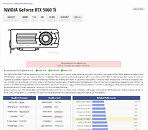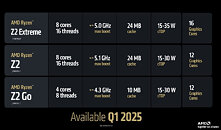
NVIDIA GeForce RTX 5060 & 5050 Mobile GPUs "Officially" Leaked by Laptop Manufacturers
NVIDIA is expected to reveal its GeForce RTX 5060 Mobile and RTX 5050 Mobile GPUs later this month, but a series of leaks—going back to last summer—have already spoiled the fun. Last month, leaks pointed to Razer and MSI's preparing cheaper of "cheaper" portable gaming PCs—featuring lower end "Blackwell" Mobile hardware. VideoCardz has spent time looking for more examples—recent detective work has unearthed further evidence of an imminent launch. Yesterday's investigative article put spotlights on Razer, Lenovo and LG. Team Green's manufacturing partners have inadvertently published official web material with multiple mentioning of pre-release GeForce RTX 5060 and GeForce RTX 5050 laptop-oriented solutions. Razer China has already reacted to VideoCardz's report; their Razer Blade 16 (2025) splash page no longer lists an NDA-busting GeForce RTX 5060 Mobile option.
Similarly, LG's Taiwanese office has scrubbed "5050" from a recently published new LG gram AI notebook press release. The edited line states: "NVIDIA GeForce RTX 8 GB graphics card is only available in 16Z90TR-E.AD88C2 model." On January 31 (2025), the Lenovo PC YouTube channel uploaded an unboxing of their refreshed Lenovo IdeaPad Pro 5 16" model. The video's description let slip crucial pre-release information, regarding an upcoming discrete graphics configuration: "optional latest NVIDIA GeForce RTX 5050 graphics, with a total power output of 135 W for strong performance." VideoCardz has deduced a speculative 65 W TDP rating for Team Green's entry level "Blackwell" mobile SKU. At the time of writing, Lenovo has not edited out the offending descriptor from their Lenovo IdeaPad Pro 5 16" (2025) featurette.
Similarly, LG's Taiwanese office has scrubbed "5050" from a recently published new LG gram AI notebook press release. The edited line states: "NVIDIA GeForce RTX 8 GB graphics card is only available in 16Z90TR-E.AD88C2 model." On January 31 (2025), the Lenovo PC YouTube channel uploaded an unboxing of their refreshed Lenovo IdeaPad Pro 5 16" model. The video's description let slip crucial pre-release information, regarding an upcoming discrete graphics configuration: "optional latest NVIDIA GeForce RTX 5050 graphics, with a total power output of 135 W for strong performance." VideoCardz has deduced a speculative 65 W TDP rating for Team Green's entry level "Blackwell" mobile SKU. At the time of writing, Lenovo has not edited out the offending descriptor from their Lenovo IdeaPad Pro 5 16" (2025) featurette.

































































































